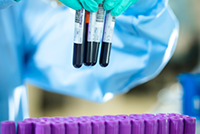The Blood Service collects an average of 3.6 blood sample testing tubes per donation, meaning our manufacturing processing centres receive an estimated 4.7 million tubes annually. Each tube is handled or touched by Blood Service staff 14 times during its testing lifecycle, totalling 70 million manual touches every year. That’s a lot of manual handling and a lot of time that could be better spent!
Recently, the Blood Service completed a ‘blueprint’ design for a One Touch Test Tube future state laboratory. The design concept can deliver efficiency by introducing total automation in tube management with the aim to reduce manual tube handling to a single touch while still maintaining quality and safety. This automation will add predictability and control to the workflow plus provide the ability to track exactly where a tube is in real time.
The future laboratory will contain the latest in infectious disease screening technologies in a connected system that will allow tubes to progress in a continuous flow from sample preparation through testing and on to storage via automation. All instruments will communicate with each other to allow the system to manage workflow and all data will be available from smart devices allowing flexible result management.
“By modelling the path of a sample tube in the ‘future lab’ concept design, we’ve identified the potential of a 54 per cent increase in functional capability using current known technology. This is realised through improved system control and increased ‘walk away’ time, which is the amount of time an automated process can operate without operator engagement. A significant change like this could provide us with the ability to process 30 per cent more tubes per hour” said Dimi Marinakis, Manufacturing Program Manager.
To benefit customers, the system will have the ability to schedule testing on a priority basis, determined by inventory requirements and customer lead times. That is, if a particular product is in high demand, the system would automatically prioritise the testing for that product, helping us ensure products are available when customers need them.
Now that the Future State Laboratory ‘concept’ is complete, work has begun on the implementation roadmap to determine how all the milestones will be staged. Multiple project teams across the Blood Service will be working in collaboration to evaluate emerging technologies with the goal to deliver a state-of-the-art testing facility. It will be a few years before the lab of the future is complete, but every step takes us closer.

